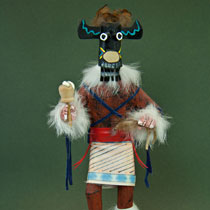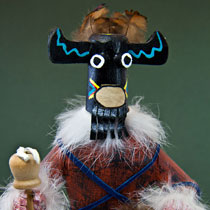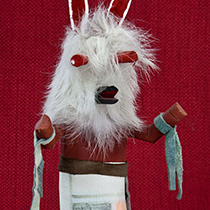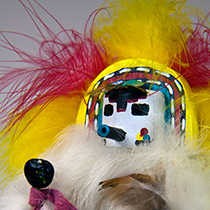Description of Figure/Doll
Kachina Indian doll made from wood. He is wearing a vinyl skirt, belt and beard. His mask (with eyes and horns) is made from wood, and he has feathers on head. He is hand painted and his hands and feet are trimmed with white fur. He is holding a wooden tool. Signed: “Broadface by : A. S. ‘99” Tag: ” Kachinas: Originally, the kachina doll was devised as a teaching tool given to pueblo children as part of their cultural and religious training. It is estimated that there are more than 250 different kachinas with several new additions added periodically. Each kachina has a specific function and is believed to be the spirit of an animal, bird, plant, object, place or person. The ancestral kachinas were supernatural being or spirits. These benevolent entities once lived among the people to teach them basic living skills for well-being. These skills included the art of hunting, tool-making, and healing. Some kachinas instructed on maintaining and restoring harmony within the village and living in harmony with nature to bring rain and fertility to the ground. There were also kachinas who taught the art of offering spiritual gratitude.”
Link to higher resolution images at ClipPix
USA: Arizona
Location: Southeast USA
Capital: Phoenix
Main language: English
Currency: US dollar
Figure/Doll
Construction: ceramic clay
Height in Centimeters: 28
Height in Inches: 11


Hopi Indians: Keeping Our Culture with Katsina Dance and Dolls
Reading Level: 5.50
I am a Hopi Indian. My name is Aponivi, and I am10 years old. Hopi means “peaceful person” in the Hopi language. The Hopis are a nation of Native American Indians. We live on a reservation in Arizona, not far from the Grand Canyon. Our nation is led by a tribal council. Almost all of our people speak English, as well as the Hopi language.
I have two younger brothers and a baby sister. My mother carries my sister on a cradle board on her back. The women of our tribe are in charge of the house and the family. My father is a farmer, and he grows corn and beans. Both of my parents love to tell stories. The stories keep the history of the Hopi Indians alive.
Another way we preserve our culture is through our kachina (katsina) dance and dolls. Kachinas are like a religion to us. We believe that kachinas can bring us rain; help corn grow; protect us from harm, etc. Each kachina is believed to be the spirit of an animal, bird, plant, object, place or person. For example there is a Wolf (Kweo), Eagle (Kwahu), Sun (Tawa) and Chief (Eototo) kachina. There are more than 250 different kachinas. They help us to live in harmony with nature.
Several times a year, we have a kachina dance. Now that I am 10 years old, I can dance along with the other men and boys. We all dress us in costume and wear a kachina mask. The dances take place from the first part of spring through the fall harvest.
To help us learn about the kachinas, our mothers make kachina dolls. My baby sister has several near her bed. The kachina dolls are carved from the roots of cottonwood trees. Then, they are clothed with leather, feathers, wood, and other materials. For example, if it is a Wolf kachina, it will have a mask with ears and a large nose.
I’m not sure which kachina I will portray in the next ceremony, but I will be proud that I am a Hopi.








